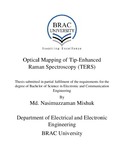| dc.contributor.advisor | Rahman, Dr. Md. Mosaddequr | |
| dc.contributor.advisor | Hoque, Md. Anamul | |
| dc.contributor.author | Mishuk, Md. Nasimuzzaman | |
| dc.date.accessioned | 2018-02-26T08:25:26Z | |
| dc.date.available | 2018-02-26T08:25:26Z | |
| dc.date.copyright | 2017 | |
| dc.date.issued | 2017 | |
| dc.identifier.other | ID 13110041 | |
| dc.identifier.uri | http://hdl.handle.net/10361/9559 | |
| dc.description | This thesis report is submitted in partial fulfillment of the requirements for the degree of Bachelor of Science in Electronics and Communication Engineering, 2017. | en_US |
| dc.description | Cataloged from PDF version of thesis report. | |
| dc.description | Includes bibliographical references (page 38-44). | |
| dc.description.abstract | Imaging technique with high-sensitivity and high-spatial-resolution at single molecular level is always a desired aspect to the researchers. In association with scanning probe microscopy and surface-enhanced Raman spectroscopy (SERS), a new technology has shown the light of hope to achieve what was thought as unachievable earlier, named tip-enhanced Raman spectroscopy (TERS). An essential tip is used in TERS instead of rough metal film. This tip gives the information of the topology of the target molecule by scanning probe technique and can magnify the Raman signal largely without any special sample preparation. Between this metal tip and surface, a ‘hot-spot’ is formed when the laser beam is applied. Conventionally in TERS theory, Raman signal enhancement factor is approximately equal to the fourth power of the local field enhancement factor at the ‘hot-spot’. In this thesis, the localized electric field in the vicinity of the metallic tip of TERS was examined and the effect of different polarization of source in mapping TERS was observed with Finite-Difference Time-Domain method (FDTD) simulation. For this simulation, tip radius and distance between tip and substrate were kept constant and incident wavelengths were varied. For the sake of simulation, Lumerical simulation software was used because of its high accuracy. | en_US |
| dc.description.statementofresponsibility | Md. Nasimuzzaman Mishuk | |
| dc.format.extent | 44 pages | |
| dc.language.iso | en | en_US |
| dc.publisher | BARC University | en_US |
| dc.rights | BRAC University thesis reports are protected by copyright. They may be viewed from this source for any purpose, but reproduction or distribution in any format is prohibited without written permission. | |
| dc.subject | Tip-Enhanced Raman Spectroscopy | en_US |
| dc.subject | Optical mapping | en_US |
| dc.subject | Localized surface plasmon resonance | en_US |
| dc.subject | Spatial resolution | en_US |
| dc.subject | Finite-Difference-Time-Domain | en_US |
| dc.title | Optical mapping of Tip-Enhanced Raman Spectroscopy (TERS) | en_US |
| dc.type | Thesis | en_US |
| dc.contributor.department | Department of Electrical and Electronic Engineering, BRAC University | |
| dc.description.degree | B. Electrical and Communication Engineering | |

